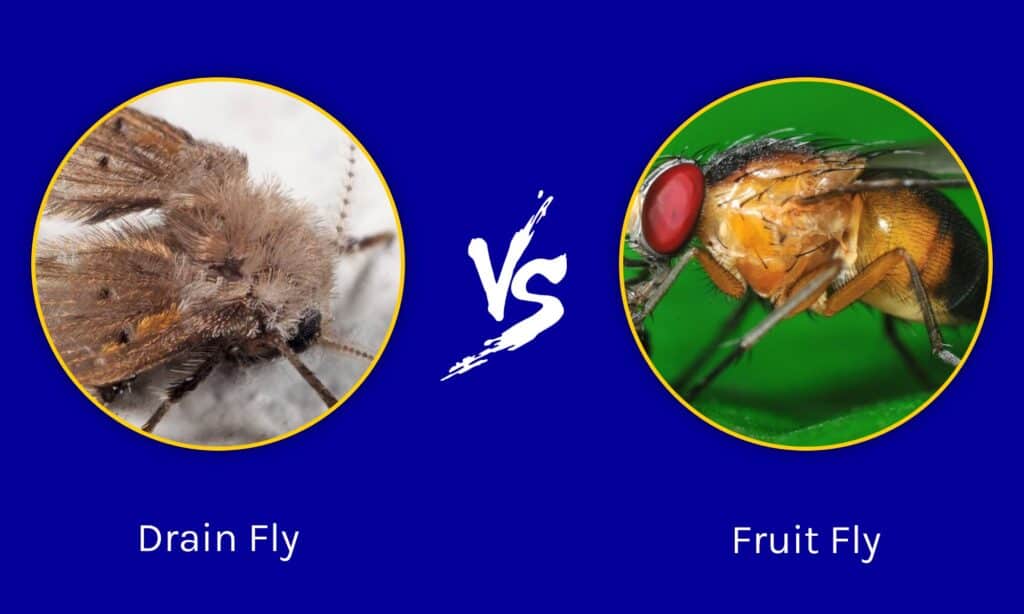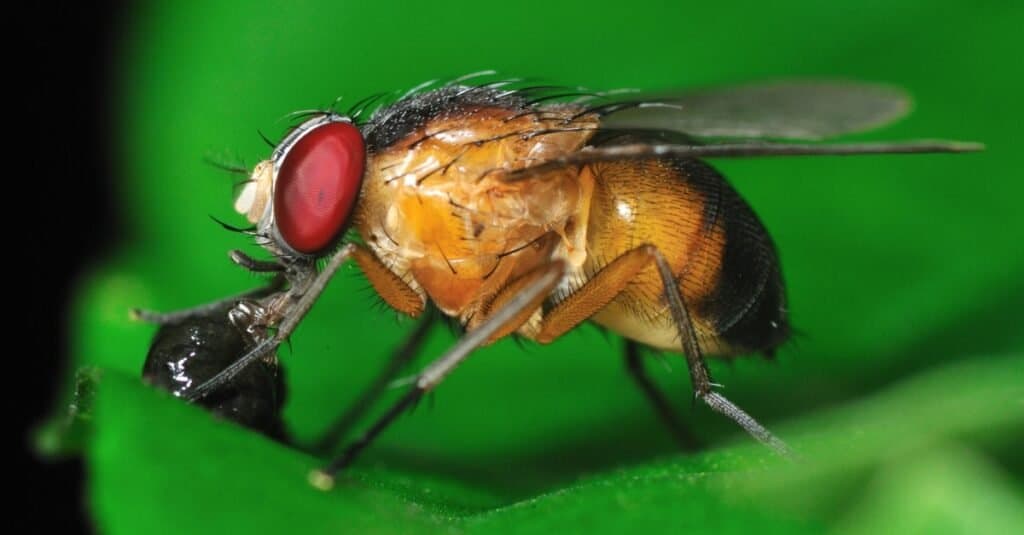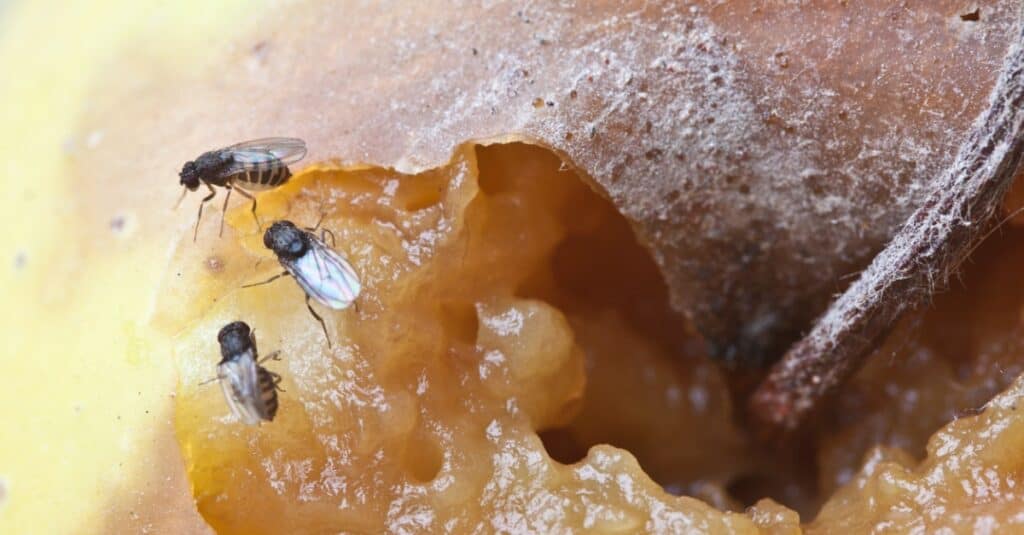Of all the household pests, none are as annoying as flies. Sure, some may be grosser or more serious, but most pests don’t fly around your head all day. Flies can end up in the house in all sorts of ways, and two of the most common flies that live in your home are the drain fly and the fruit fly. Neither of these species is as large as the housefly, but they are both pests that you probably don’t want around. Today, we are going to be taking a look at these two creatures and learn what makes them different. Drain Fly vs Fruit Fly, how do you tell them apart?
Comparing a drain fly and a fruit fly

| Drain fly | Fruit fly | |
|---|---|---|
| Size | 1/8th of an inch | A bit over 1/8th inch |
| Color | Dark-colored, black in appearance. | Tan, brown, black, red eyes. |
| Fur | Wings are covered in fine hairs giving the appearance of fur. | No visible fur or fuzz. |
| Diet | Flower nectar and organic material in water. | Fruit, leaves, plants, organic material. |
| Pest characteristics | Breed in sewer slime found in drains, can quickly grow in number and annoyance. | Breed in decaying food, annoying in kitchens and rooms with plants. |
| Removal tactics | Cleaning your pipes, vinegar trap. | Vinegar trap, removal of organic material. |
The 5 main differences between a drain fly and a fruit fly
The primary differences between a drain fly and a fruit fly are their coloration, breeding cycle, and diet.
Drain flies and fruit flies are both common sights in any house, and they can be quite annoying. These pests can pop up within a few hours and have dozens of individuals flying around within a day. Although these are similar pests to humans, they have different life cycles and are different creatures altogether.
Drain flies are most common in bathrooms and kitchens, where they can breed in the drains and pipes of sinks. Their name comes from their breeding habit of laying eggs in the slime that coats dirty drains. They can soon be buzzing around your home, reproducing, and being a bother.
Fruit flies are similar to drain flies in that they are also found within human homes. They feed on rotting organic matter and love kitchens and areas with plants. Fruit flies are attracted to fruits, vegetables, and plants that they can suck nutrients from. Like drain flies, a few fruit flies in your home can turn into a small swarm rather quickly.
Let’s explore what makes these pests different, plus a few tips on dealing with them, in detail below.
Drain Fly vs Fruit Fly: Size

Drain flies are usually a bit smaller than fruit flies.
©Cherdchai Chaivimol/Shutterstock.com
To humans, both flies probably seem pretty similar in size. When you look closely, however, you can see a small difference. Also, things are complicated by the fact that there are thousands of species of drain flies, all of which have their own characteristics. In most American homes, however, drain flies are a bit smaller than fruit flies, coming in at 1/8th of an inch.
Fruit flies are a bit bigger than drain flies, usually measuring slightly larger than 1/8th of an inch. The difference between the two is marginal but present. The best way to tell the difference is by knowing what a fruit fly looks like, as there are so many species of drain fly. Fruit flies resemble houseflies but look like a smaller, more transparent version.
Drain Fly vs Fruit Fly: Color

Fruit flies are brown with red eyes.
©Jordan Lye/Shutterstock.com
Color is a great way to tell the difference between the two. Drain flies are generally dark-colored, with most of them being black or brown. While flying, they look like tiny black specks floating through the air. Their wings are slightly translucent, although they have dark structural elements to them.
Fruit flies are generally brown or tan in color and have distinctive red eyes. The bright red eyes of the fruit fly are usually the best way to identify these pests as it is a somewhat uncommon trait to see among other insects. Certain genetic mutations can cause white, brown, or sepia eyes, but they aren’t as common.
Drain Fly vs Fruit Fly: Fur
Drain flies differ from fruit flies through a noticeable layer of “fur” on their wings. This fuzz isn’t actually fur but small hairs that are visible to humans. Many people refer to drain flies as “moth flies” because of the fuzzy effect that the hairs give to the little creatures.
Fruit flies don’t have hairs that are visible to a regular human eye.
Drain Fly vs Fruit Fly: Diet

Fruit flies prefer sugary liquid from fruits and other plants.
©iStock.com/hoja_viva
The diet of the two flies reflects their names quite well. Drain flies eat flower pollen and organic material found in standing water. They are often in drains as they love to eat the layer of organic material that grows in the slime that coats pipes. Since they feed and breed in drains, humans generally encounter them around kitchen sinks and bathrooms.
Fruit flies love to eat any organic material, especially sugary things. They will feed on fruits, vegetables, soda, sugar water, or juice. As their food source is found in most kitchens, that’s where most people encounter them.
Drain Fly vs Fruit Fly: Pest characteristics
Drain flies are generally harmless and don’t carry any diseases that would harm humans. They are found in drains as they feed on the organic slime coating the walls. Additionally, drain flies lay their eggs in the slime and repeat their lifecycle. They are a nuisance to humans but aren’t cause for concern.
Fruit flies are harmless flies that feed on sugary liquids found in fruits, vegetables, plants, or human foods. They are found in kitchens where they can find food to eat and lay their eggs in. Although they can be annoying, they are sponges for bacteria since they feed on contaminated substances.
Drain Fly vs Fruit Fly: Removal tactics
Although these insects have some differences, they can be removed through a similar method. Simply take a small dish and place equal parts of water and apple cider vinegar inside, at least 1/4 inches deep. Then, stir in some dish soap and place where the insects congregate.
The vinegar attracts the flies, and once they land, the soap breaks the surface tension of the water, letting them slip in to drown. A well-placed dish can catch hundreds of insects over the course of a few days and is incredibly inexpensive.
The photo featured at the top of this post is © iStock.com/Tomasz Klejdysz
Thank you for reading! Have some feedback for us? Contact the AZ Animals editorial team.






